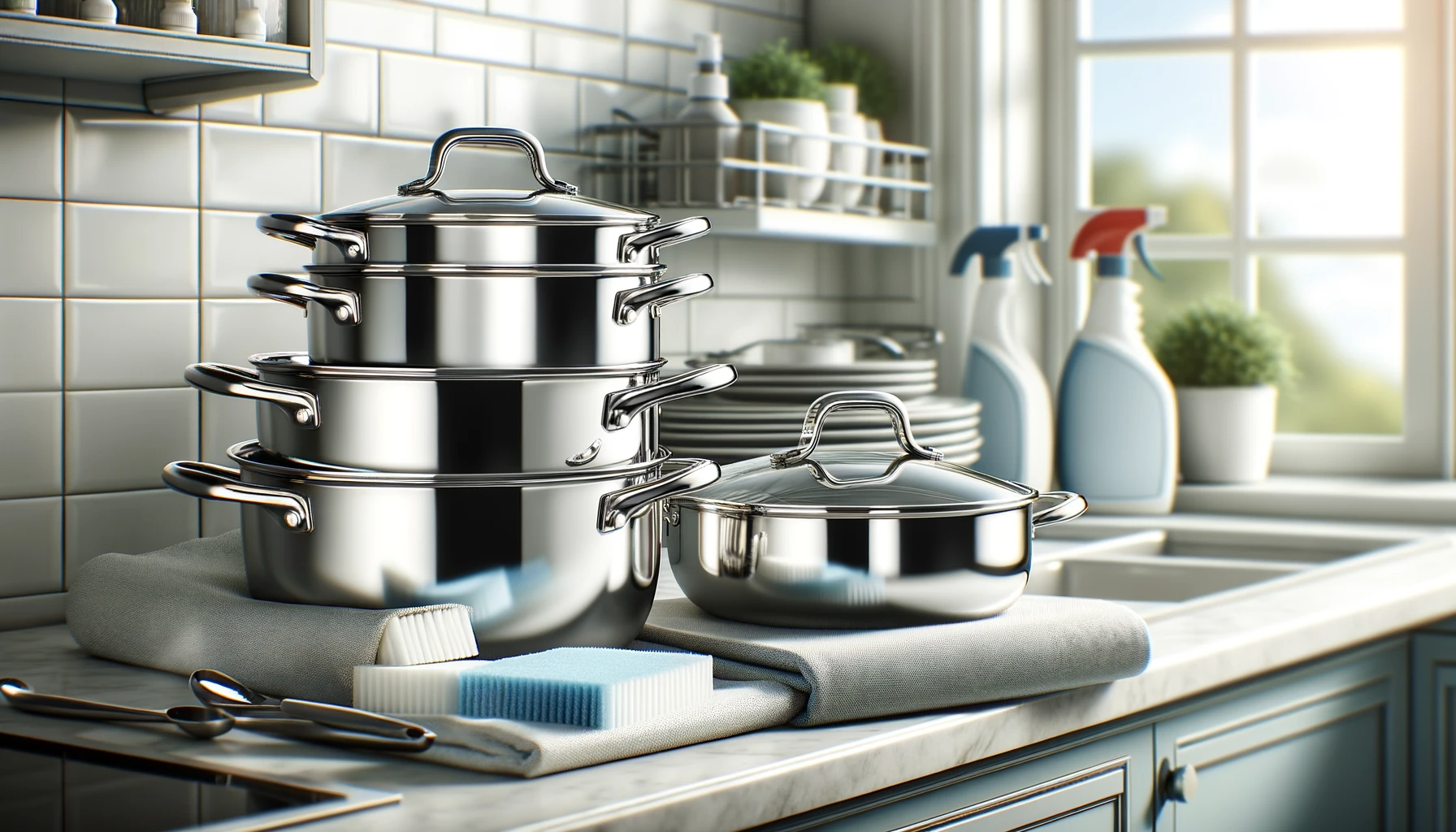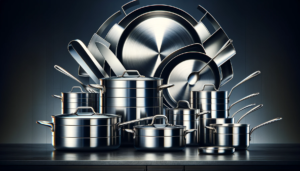If your Rachael Ray stainless steel pots and pans have lost their shine and show burnt-on stains no matter how much you scrub, don’t despair – effective cleaning is possible.
This complete guide covers supplies needed, step-by-step interior and exterior cleaning methods, removing stubborn discoloration and water spots, plus storage and maintenance tips for Rachael Ray stainless steel cookware.
Let’s dive into the key techniques and handy tricks to make Rachael Ray stainless steel look new again and maintain its beauty long-term.
How to Clean Rachael Ray Stainless Steel Cookware?
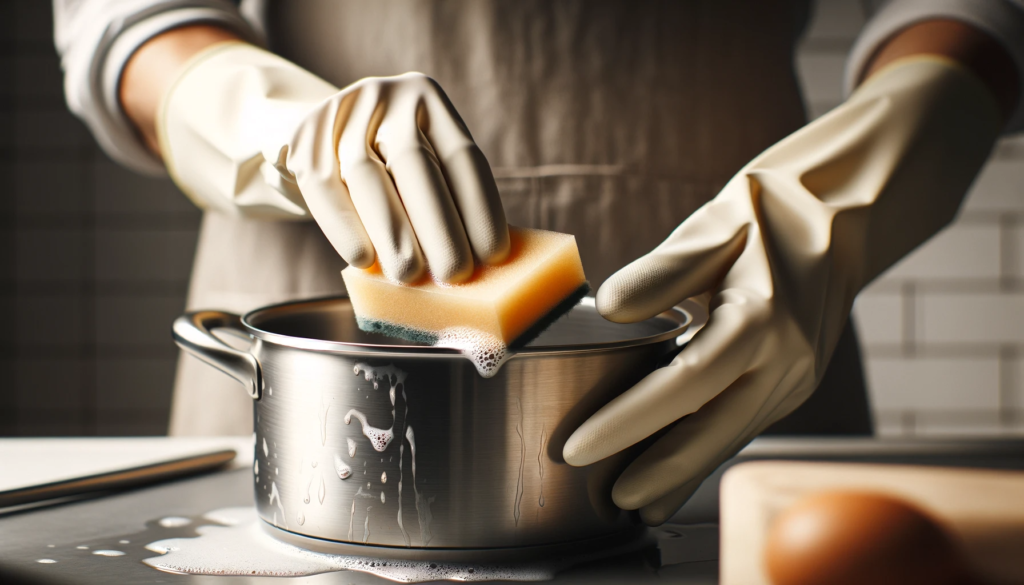
The key steps for cleaning Rachael Ray stainless steel pots and pans involve using a soft sponge or cloth with dish soap and warm water for both the interior and exterior surfaces.
For stuck-on residue, let pans soak in hot soapy water then gently scrub interiors with baking soda paste if needed.
For discoloration, try a baking soda paste or white vinegar soak.
Always rinse well, hand dry completely, and apply a light layer of oil before storage to maintain the stainless steel finish.
Below we’ll explore a complete step-by-step guide going more in-depth on these methods and other important care tips for keeping Rachael Ray stainless cookware looking its best for years of cooking.
Supplies Needed
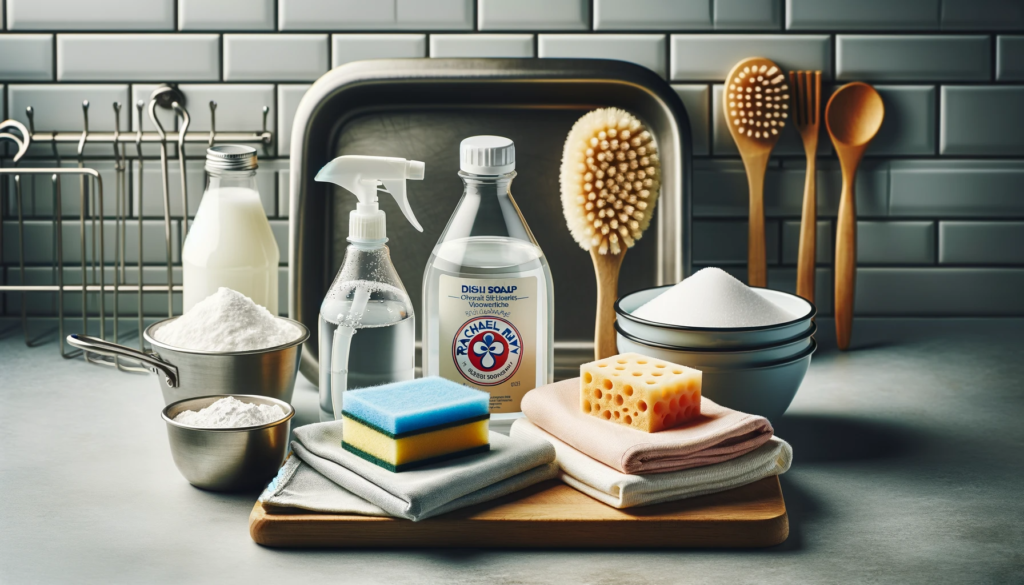
When it comes to cleaning stainless steel pots and pans, having the right supplies on hand can make the process easier and more effective.
Here are some key items to have ready before tackling stainless steel cookware cleaning:
Dish soap or other mild detergent is useful for most day-to-day cleaning needs.
Avoid harsh soaps or cleaners, as these can damage the cookware surface over time.
A soft liquid dish soap diluted with warm water often does the trick for basic cleaning.
A soft sponge or dishcloth made of microfiber or other gentle fabric helps lift cooked-on residue without scratching.
Unlike abrasive scrubbing pads, soft cloths protect the cookware’s finish.
Baking soda’s mild abrasiveness dissolves some forms of grime and stuck-on food debris.
Mix baking soda with just enough water to form a paste, then apply it to soiled areas as a cleaning booster before scrubbing.
White vinegar’s acidic properties break down certain deposits and stains on stainless steel over time.
Either pure vinegar or a vinegar-water solution helps remove discoloration.
Be sure to rinse vinegar off thoroughly after cleaning stainless pans and pots.
Water both for filling cookware when soaking and for rinsing after scrubbing is essential.
Hot water typically works better than cold for most cleaning purposes.
Avoid hard tap water if possible, as mineral deposits can build up on stainless steel’s surface.
Filtered or distilled water is a better option when available.
Having these basic items ready ensures you can clean stainless steel cookware effectively and gently for optimal results.
Check your supply levels before cooking any messy or baked-on foods that might require some extra cleaning power afterwards.
Cleaning the Interior
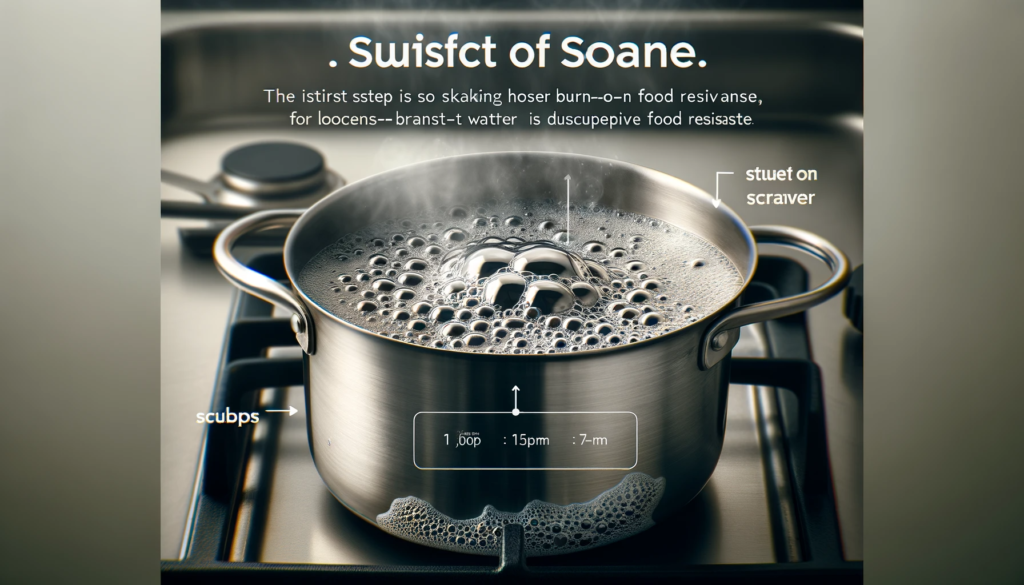
Keeping the inside of stainless steel pots and pans clean after cooking helps maintain their performance and appearance over time.
Here is a step-by-step process for cleaning stainless steel cookware interiors:
If burnt or stuck-on food residue remains in the cookware after use, fill the pot or pan with hot, soapy water and allow it to soak for at least one hour.
In some cases, you may need to let it soak overnight if food is extremely stuck on.
The hot water and soap will slowly soften and loosen debris from the interior surface with extended soaking time.
After soaking, use a soft sponge or microfiber dishcloth to gently scrub the inside of the cookware.
Apply light pressure while scrubbing in a circular motion to lift residue without scratching the finish.
If needed for extra scrubbing power on tough spots, make a paste by mixing baking soda with just enough water to form a thick solution.
Use this paste to gently scrub affected areas before rinsing.
Rinse the interior of the stainless steel cookware thoroughly with clean, preferably filtered or distilled water.
Continue rinsing until all soap and debris are removed.
Avoid using cold water, as lukewarm or hot water removes soap more effectively.
Thorough rinsing prevents soap residue buildup over time.
Gently handwashing stainless steel pots and pans after each use is key to preventing extensive buildup that requires extensive soaking or scrubbing to remove.
Getting into a daily cleaning routine for cookware interiors simplifies the process.
Cleaning the Exterior
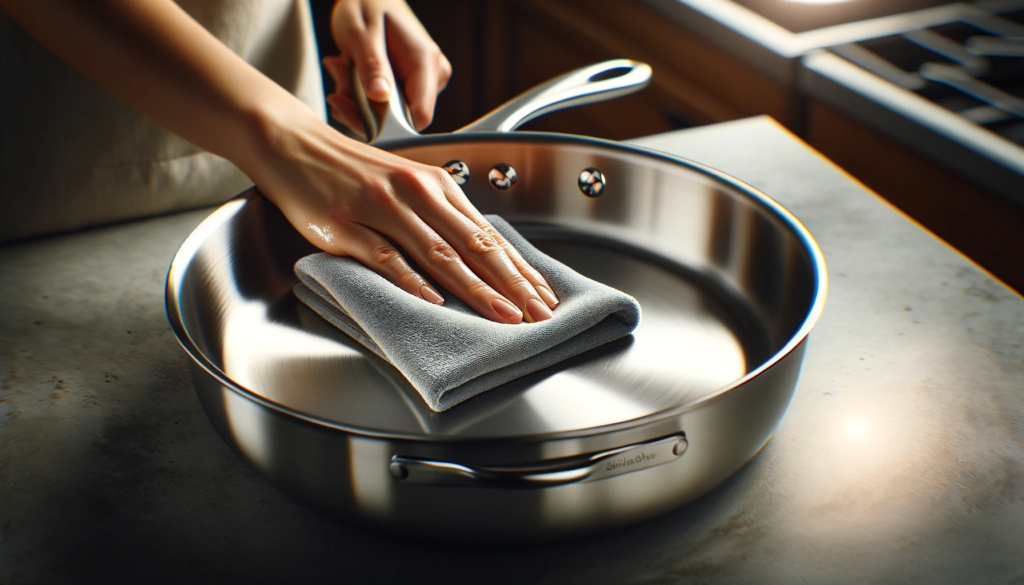
While stainless steel pot and pan interiors see the most intense exposure to food residue, oil, and other cooking mess during use, their exteriors also require regular cleaning as well for a like-new appearance.
Here are tips for effectively cleaning the outside surfaces of stainless steel cookware:
After wiping out any drips, spills, or splatters on the exterior while washing interiors, wash the external surfaces with warm water mixed with a small amount of dish soap or other mild detergent.
Use a soft microfiber cloth or sponge to gently wipe down all exterior surfaces, including handles and lids.
Avoid using harsh scrubbers or abrasive pads, as these can create microscopic scratches on the cookware finish over time with repeated use.
If the exterior has significant baked-on residue, grease, or hard water staining, make a paste by mixing baking soda with just enough water to form a spreadable solution.
Gently rub this paste onto affected areas using a soft cloth or sponge.
Let it sit for several minutes before scrubbing and then rinsing clean.
The baking soda’s properties help lift stubborn buildup without damaging the stainless steel finish.
After washing the cookware exterior, rinse thoroughly with clean water.
Avoid cold water, as warm or hot water removes soap residue better.
Make sure to dry the exterior surfaces immediately with a soft lint-free cloth or towel after rinsing.
Allowing stainless steel cookware to air dry can lead to mineral deposits from water, especially if using hard tap water.
Getting into the practice of wiping down stainless steel pot and pan exteriors while washing interiors after every use prevents extensive buildup or sticky residues requiring heavy-duty cleaning methods later on.
Consistent exterior care helps stainless steel maintain its shiny, like-new appearance as well.
Removing Discoloration or Water Spots

Even well-maintained stainless steel cookware eventually shows surface discoloration, clouding, or water spotting from mineral deposits over consistent use.
Addressing these issues promptly restores appearance and performance.
Here are some effective methods for removing common stainless steel aesthetic issues:
To treat surface clouding, blotchy discoloration, or water spotting on stainless steel pots or pans, first try making a paste of baking soda and water.
Apply this paste to affected areas and allow it to sit for two to three minutes before gently scrubbing with a soft cloth or sponge.
The baking soda serves as a very mild abrasive to lift stain deposits from the cookware surface when combined with gentle scrubbing action.
Rinse thoroughly after scrubbing and dry immediately to check if the issue has resolved.
If discoloration persists, pure white vinegar often helps remove stubborn staining or mineral buildup on stainless steel.
Soak a soft cloth with undiluted white vinegar and rub it onto affected areas.
Allow it to sit for no more than 10 minutes before rinsing to avoid damaging the finish.
In most cases, the acetic acid in vinegar breaks down mineral staining for easier removal upon scrubbing and rinsing.
Avoid using vinegar soak methods for longer than 10 minutes at a time, as extended acid exposure could lead to corrosion issues over time.
Catching discoloration and water staining early makes removal easier compared to allowing buildup to worsen over many uses.
Getting into consistent stainless steel cleaning habits prevents minor aesthetic issues from becoming more pronounced or permanent.
Storing and Maintaining

Proper storage and maintenance habits prevent stainless steel cookware from degrading over time.
Here are some useful tips for keeping pots and pans looking their best after cleaning:
Always dry stainless steel cookware thoroughly with a clean, soft towel immediately after washing.
Allowing moisture to air dry on surfaces leads to mineral residue deposits over time.
These deposits then require removal via repeated acid treatments or abrasive scrubbing, both of which degrade cookware.
After fully drying all surfaces, apply a small amount of cooking oil or spray to interior surfaces using paper towel or a soft lint-free cloth.
Rub the oil across the entire interior surface coating the bottom and sides.
This oil barrier prevents moisture-related surface corrosion during storage.
Before using the oiled cookware again, wash the interior with dish soap and warm water to remove any rancid oils.
When storing stainless steel pots and pans, avoid placing other stackable items like plates or bowls inside them.
Added weight compounds pressure points and friction against the interior surface that could compromise the polished cookware finish over time.
Instead, store each stainless steel piece separately or with the included lid only.
Handwash stainless steel cookware over machine washing whenever possible, even if labeled dishwasher safe.
The intense heat and harsh detergents in dishwashers degrade stainless steel over time.
For cookware used daily, replace deteriorating soft dishcloths or sponges monthly for optimal cleaning ability.
Routinely inspect your stainless steel pots and pans for signs of abrasion, corrosion spots, and scratches.
Addressing minor cosmetic issues promptly reduces worsening over extended use.
With some basic protective steps integrated into your usage and storage habits, stainless steel cookware delivers beauty and convenience for many years of cooking.
Conclusion
Properly caring for stainless steel cookware requires some diligence, but taking the time to follow these cleaning, storage, and maintenance steps pays dividends through years of service.
Implementing good habits keeps Rachael Ray and other stainless steel pots and pans looking like new for as long as possible.
With the right methods, removing discoloration and residue is achievable at home without damage.
Follow this complete guide for restoring shine and elegance to well-loved stainless steel cookware items when needed.
